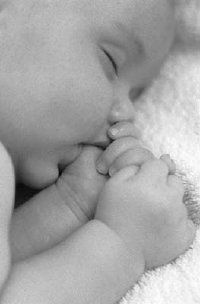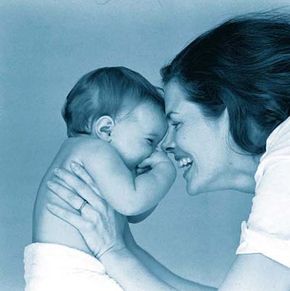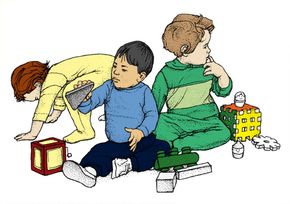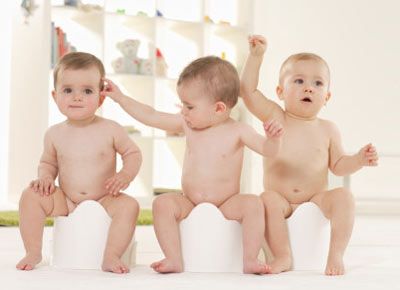Social behavior begins very early in the lives of human beings. Infants respond to people almost from the moment of birth. In fact, if you began the bonding process with close skin contact immediately after your baby was born, you probably felt she was definitely aware of you, reaching out to you. Newborns are attracted to human faces, and they like the sound of human voices, especially female voices. Soon your new baby's eyes follow your movements in a room, then her head turns to watch you. At three or four months, your baby responds happily to smiling people, then smiles at the sight of any approaching face. The baby smiles -- you smile -- her smile broadens. Thus, social interaction begins; the baby has learned to get a reaction from another person. She even tries to mimic you when you stare, stick your tongue out, or make faces. One day you'll notice your baby quiets if you speak or sing as you come near the crib. It won't be long until she makes a sound in response to your voice.
At five to eight months, your baby learns how to be cute, how to get your attention by pretending to cough or by doing something that has made you laugh before. She knows the difference between familiar people and strangers and may show fear of strangers. When your baby is somewhere between the ages of eight months and a year, she'll cooperate in the singing games and finger plays with which you've been entertaining her. Soon she adores having an audience and delights in performing the "bye-bye" ritual and any other routines that get attention.
On this page, we examine the newborn's first interactions with her family and through the first years. Remember that babies vary greatly in their social development. The indicated age ranges are guidelines, not absolute requirements.
The First Social Set: The Family
The immediate family -- mother, father, siblings, and a caregiver, if the baby has some kind of child care -- is your baby's first social set, a select and fortunate group. All of you will outdo yourselves to entertain and please the baby, and your greatest thrills come when he responds and reciprocates. Remember, though, that the key word in all human behavior is unique. Your baby is as different from all the other babies in the world as each snowflake is different from all others. Antics that sent your older child or your neighbor's baby into paroxysms of giggles and gurgles may very well make this baby cry and pull back. Take your cue from your child: If he startles easily or seems frightened by your loud noises, funny faces, or sudden actions, ease up.
At about one year of age, your child is extremely sociable. He loves being part of any and every family gathering and obviously adores everyone. The baby happily goes on your rounds of shopping and errands with you, pays and receives social visits with you, and thoroughly enjoys just being with you around the house. Anything goes, in fact, as long as a family member is close at hand.
But this changes. The push toward independence you've read and heard about becomes reality, and at a point when he is somewhere around 18 months of age, your baby appears to have outgrown any need for you. He barely acknowledges your presence in daily life, except to say "No" a great deal. Walking, running, climbing stairs, exploring, and satisfying curiosity about everything and anything are all-engrossing. Occasionally, he reverts to the old baby ways of love and play, but, in general, the child at this age concentrates so hard on self and environment, adults seem to exist for no reason other than to satisfy his desires. The exception to this behavior occurs when there's trouble; no one but Mommy or the primary, daily caregiver can handle a cut or bruise or make a stubborn toy work the way it should.
Sociability returns in time, but by the time it does, your baby's social set includes playmates and others outside the family. You are never again as all-important to your child as you were for the first year, which is as it should be. Learning to let go is among the most important of parents' lessons.
Separation Anxiety and Other Fears
Love takes many forms, and your baby may often show her love for you by resisting any separation from you. This is completely natural. Your baby is aware of total dependence on you for survival; if you are absent, fear takes over. Contrary to what many people think, you do not break your baby of needing you by forcing frequent or lengthy separations. The truth is the more secure you can make her feel, with your presence and by holding, cuddling, and reassuring her, the more confident and unafraid she will become.
You notice that something she once found frightening -- perhaps the vacuum cleaner or the dishwasher -- is no longer so from the safety zone of your arms. Other unreasonable fears come and go suddenly; some common ones are fear of dogs or cats, the ghosts and monsters that come in the night, emergency sirens, thunder, and people in unusual garb, such as doormen and nuns in habits, or those in costume, such as clowns or Santa Clauses. These frights pass and are forgotten if you support your child through them.
If your baby seems unable to be without you for a single waking moment, realize this is one of the many phases she will go through and do your best to go along with it. Don't force a stint in the playpen or an exercise period in the middle of the living room floor if your infant seems terrified of being in the center of all that empty space. Don't make an obviously reluctant baby go to someone else, even if it's a relative whose feelings are apt to be hurt by the rejection. Leave the door to the baby's room ajar at bedtime, and reassure her you're near by letting her hear your voice from wherever you are in the house. Try not to show irritation at what you know to be unreasonable fears; you only make your baby feel less secure than ever. Don't worry about spoiling a clinging baby or overprotecting her by avoiding situations you know frighten her. She has a built-in human drive to be mature and independent.
Many babies are reluctant to be left with babysitters. When Mommy is out of sight, she is gone, and children younger than about a year of age cannot yet reason well enough to know she will be back. Some parents believe they simply must not leave their children at this point; others insist they must get out, and both they and their children are better for an occasional separation. If you're in the latter group, your best choice for a sitter at first is someone your child knows -- Grandma or another relative is often ideal. You may wish to have a sitter your baby doesn't know come for a visit or two when you are home, so the two can get to be friends.
If you must leave a comparative stranger in charge, have the babysitter arrive early enough to get acquainted with your baby while you are still there. Never sneak off, agree most parents; use a regular good-bye ritual that includes kissing good-bye and waving. Come home when you've said you will, and set the time as "after your nap," instead of "at three o'clock," for a small child who doesn't live by the clock yet. If you drop your child off at the sitter's house, even if a loving and beloved Grandma is the sitter, be sure to take along the favorite stuffed animal or blanket.
Siblings as First Friends
Your baby's siblings are his first friends. With luck, your children will remain good friends for life. But the relationship won't always proceed smoothly, and a certain amount of "sibling rivalry" is normal and expected. At first, your concern is to help your older child handle jealousy at being replaced by involving her in the care of the baby. As you teach the older child how to play with the baby and how to amuse him, you'll see the baby respond. The baby displays admiration for an older child's skills and accomplishments and the pure pleasure of being allowed in her company. Later, the younger child may be jealous of the older because of those very skills and accomplishments, but in the early days there's nothing like having a big brother or big sister to watch and love.
Grandmas and Grandpas, Aunts and Uncles
The time to start a loving relationship between grandparents and other older relatives is as soon as possible after the birth of your baby. The way to keep such wonderful relationships thriving is to keep contact open and frequent. Ideally, Grandma and Grandpa live down the street or around the corner, and the other relatives live not much farther away. You share holidays, and the families are often in one another's homes for quick visits or meals. When the kids are a little older, they look upon every home in the family as partly theirs.
Unfortunately, in the typical family today, extended family members are not always within easy visiting distance, perhaps not even in the same state or region of the country. Some of the people you wish could be close to your baby may be able to see her only rarely, when either they or you drive or fly to visit. Between visits, it is up to you to help your child remember the relatives and to help both the relatives and the child feel close to one another. Keep your relatives informed about your child's development; letters, phone calls, pictures, and video and audio tapes help. Show your child pictures of the relatives, use their names often, and tell stories about your childhood that include them.
A sad fact is long-distance visits are sometimes exhausting for parents, children, and relatives alike, and unsatisfactory for all because of unreasonably high expectations and too much togetherness in too short a period of time. Routines are upset, and the schedule of activities may be too crowded; there may be neither enough room in the house nor hours in the day for anyone to have the privacy and time alone that everyone from the oldest grandparent to the youngest infant needs.
Handling family visits with grace takes practice, along with consideration and goodwill. Lowering your expectations helps. Don't expect grandparents and other relatives to find your child perfect and your methods of child care irreproachable. Don't for a minute think your child will not, at some time during the visit, display unattractive habits and perform unpleasant acts normal for her age. Don't dream you can go all the places, see all the people, and do everything you want to. Above all, don't worry about the relatives spoiling your child. A little coddling and extra attention and a little relaxation of the rules make a visit more special and memorable.
Between the ages of one and three, your child is ready to branch out socially. Though learning to actually play with other children effectively takes a while, she wants to be around them, if only as an observer. She learns a great deal from this observation. Move to the next page for a discussion of your child's social interactions with other children.
This information is solely for informational purposes. IT IS NOT INTENDED TO PROVIDE MEDICAL ADVICE. Neither the Editors of Consumer Guide (R), Publications International, Ltd., the author nor publisher take responsibility for any possible consequences from any treatment, procedure, exercise, dietary modification, action or application of medication which results from reading or following the information contained in this information. The publication of this information does not constitute the practice of medicine, and this information does not replace the advice of your physician or other health care provider. Before undertaking any course of treatment, the reader must seek the advice of their physician or other health care provider.






